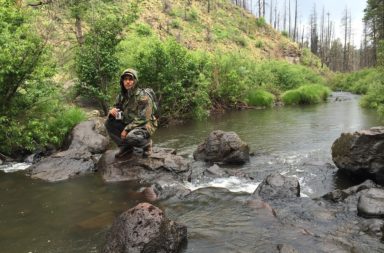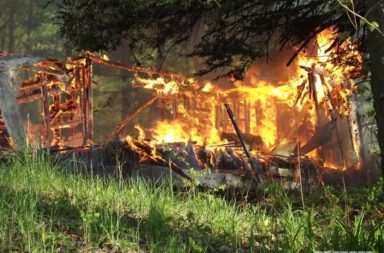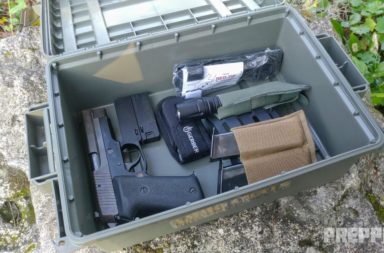As a young Airman teaching students at the United States Air Force Survival School, I was posed a riddle by one of my officer students.
He said to me, “Imagine you are lost in the woods and you come across a cabin in the middle of nowhere. You enter the cabin and there is a lantern, fully functional and ready to go. There is also a wood-burning stove with paper and kindling ready to go. Lastly, there is a stone fireplace with tinder and kindling ready to go. What do you light first?”
I replied, “I would light the fireplace.” A large smile spread across his space and he said, “Uh uh, you light the match first!”
Then it was my turn to smile and reply, “But sir, we don’t use matches!”
In the modern world, most people aren’t ready to use anything but a lighter and lighter fluid to start a fire. Having to use wooden matches is becoming a thing of the past. Yet if you are in a dire situation in the woods, knowing how to use various items to start a fire could mean the difference between life and death. First though, you need to know what materials to gather and how to prepare them for that fire.
Author’s note: I will try and use examples that are relevant to everyone, including children. This will allow anyone to have the same base of reference when discussing various survival topics, whether 5, 25 or 55 years old.
Firecraft Basics
- Every fire needs three things: oxygen, fuel and a heat source.
- Oxygen – Too much, strong winds; too little, you smother your fire with too much materials.
- Heat Source – Lighter, matches, metal matches (ferrocerium rod), embers created by primitive fire starting methods such as a hand drill or bow and drill.
- Fuels – These fall into three subcategories; tinder, kindling and larger fuels
- Tinder is fine, fibrous, hair like, very easy to ignite with just a spark or a match. Tinders can be natural, such as grasses, mosses or barks. Man-made tinders can be such things as fire paste, cotton balls and petroleum jelly (refer to photos), and even hand sanitizer as it has a high alcohol content. Be care when using hand sanitizer because it burns clear and the flame is virtually invisible until wood is lit; avoid burning yourself while using.
- Kindling is small sticks or twigs from chopstick size to thumb size.
- Larger fuels are bigger than thumb size sticks, two or three fingers large to wrist size and larger. Obtaining larger fuels will usually require a larger cutting tool such as an axe or machete.
How To Make Cotton Balls and Petroleum Jelly Tinder

- Gather what you will need. You DO NOT need any name brand items.
- Turn the storage bag inside out and grab a huge dollop of petroleum jelly. Then turn the bag right side out, like normal.

- Add approximately 20 to 25 cotton balls.

- Mix the cotton balls and petroleum jelly together until the cotton balls are saturated. This will be a versatile and easy to use tinder, even in wet or snowy conditions.
If you are using logs as kindling they should be approximately the size of your calf. You can take a log and cut it in half multiple times to create kindling. You can also take a flat piece of wood and scrape it to make tinder that can be used to start a fire.
In the woods you want to use some sort of cover to help start your fire. Underneath a large tree with large limbs, a cave, the downwind side of a rock overhang, or underneath a shelter that you build to protect you. If you can prepare your tinder, kindling and fuels in this shelter it helps prevent them from getting wet.
In addition, you will want to use a platform and a brace to set your materials upon.
The platform helps to ensure the fuels stay dry and aren’t soaking up moisture from the ground. The brace allows you to regulate the flow of oxygen in your first stages of building your fire. After you light your tinder, then add the smaller kindling using a “fire lay.”

This is merely an organized method of placing your wood on the tinder to give you the best chance of turning your small fire into a large fire more quickly and efficiently.
When making a platform from a split piece of wood, you can also use a piece of bark or several small logs or limbs placed side by side if necessary. In this firecraft example, only three soaked cotton balls are being used.
I would usually start with tinder on the platform, cotton balls and petroleum jelly usually. I would use three to five cotton balls pulled apart to easily catch a spark. Once they were lit, I would put the wood on using a grid fire lay.
After a few layers I would use a teepee fire lay and then a log cabin one to get the fire to really build and produce coals. Once the fire was well lit I would then add half or full sized logs to maintain the fire indefinitely.

Teepee Fire Lay

I lit the tinder with a match. The flames are approximately 5 inches high.

These basic principles can be used any time of the year and in any environment. I have built fires in -20 degree temperatures and 30-something degree temps while it was raining or snowing. The process I used to start these fires was always the same and the principles NEVER changed.
Starting A Fire In Inclement Weather
Following the right techniques is what has made me successful at igniting a fire when it was a calm day or when the winds were blowing at 20 miles an hour.
If you encounter strong winds there are ways to block the wind to help your fire light. The first method is to build a wall in front of your fire. Don’t build a standard wall but a “V” that cuts into the wind and forces the wind to go off to the side of where you are trying to light your tinder.
The other option is to dig down, a few inches to a foot, to allow the air to pass over and not hinder you lighting the tinder.
When dealing with a large amount of precipitation, snow or rain, it may be necessary for you to cover your tinder and fuels while you prepare them. During a trip in Western Washington state, I had to build a fire in a downpour. I used a poncho to cover my fuels while splitting the logs. I even had to put the poncho over me and the tinder so I could get it lit because it was raining so hard. I then had to add more tinder to dry the small sticks out to where they would light. This was the most difficult fire I ever had to build but I learned some valuable lessons from this experience.
The largest lesson I learned was to ALWAYS stick to the basic principles and PREPARE! Have all the materials I would need and plenty of extra to spare. I have matches, lighters, and metal matches in my home, car and backpack. I have various tinder in all of these as well.
When I build a fire I prepare THREE TIMES as many materials as I think I will need. This will ensure that if your fire is struggling you will have plenty of materials to get it going.
Conclusion
These are just basic principles, FIRECRAFT 101. In future articles I hope to delve more deeply into other natural tinder and other fire starting methods. With fall here and going into winter, this is the best time of the year to practice for those emergency situations.
Anyone can start a fire in the summer when it’s dry, the real test comes when you have to build one under very stressful conditions. Good luck future fire gods!


